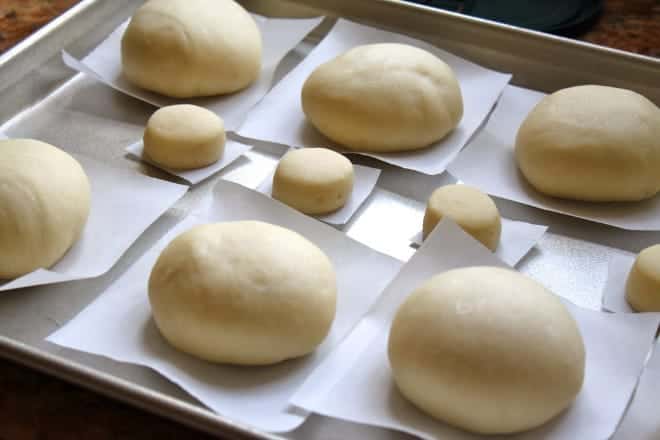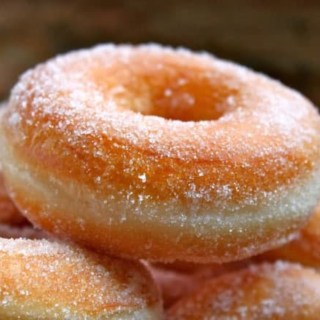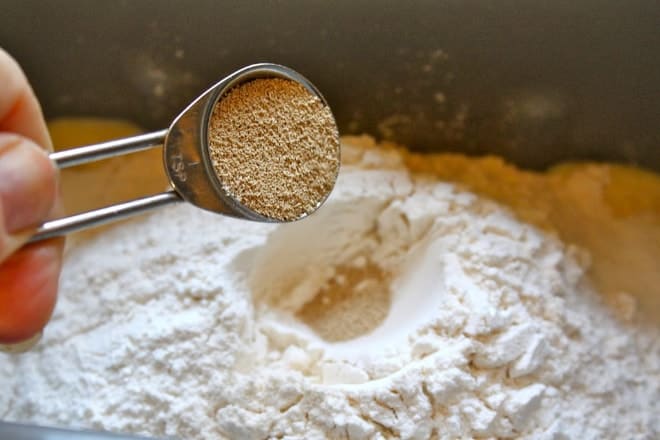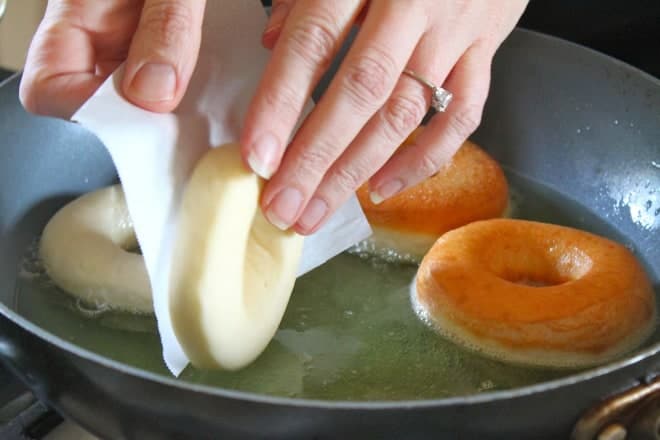Perfect Yeast Doughnuts (Donut Recipe with 3 Fillings)
Perfect yeast doughnuts are easy to make at home if you have the right recipe. You now have that recipe in your hands (or on your desk). What are you waiting for?
Who can resist perfect, soft and fluffy doughnuts?
As an Amazon Associate I earn from qualifying purchases.

Especially if it is a fresh, fluffy homemade yeast doughnut filled with raspberry jam and fresh cream? Not me!
If you think that yeast doughnuts are difficult to make, think again, especially if you own a stand mixer or bread machine. You can make ring doughnuts, filled doughnuts, or doughnut holes. I just want you to know that one batch of these beauties will disappear within seconds. However, don’t take my word for it, read the comments!
You may also enjoy my VEGAN donuts recipe!

Incidentally, I’ve linked to the bread machine I have, but any bread machine with good ratings will work (like the one I linked to above), and they are much less expensive.
I also have an Italian Christmas doughnut recipe: frittelle! I just LOVE donuts!

Frequently Asked Questions are Under the
Printable Recipe Below
✧
How to Make Yeast Doughnuts
adapted from a recipe in The Bread and Bread Machine Bible
makes about 16 ring doughnuts
SEE PRINTABLE RECIPE BELOW FOR MORE EXPLICIT DIRECTIONS FOR USING A STAND MIXER OR BY HAND
The measurements are critical in this recipe, so a scale is necessary. (This is why there are no cup measurements-please do not ask for them.)
Too many readers were not having success with this solid, tested recipe, and the only reason I can think of, is difference between using cups versus a scale (volume vs weight). The ONLY way to obtain the correct amount of flour and other ingredients is by weighing them.
FULL PRINTABLE RECIPE BELOW
Ingredients
- water
- buttermilk
- egg
- butter
- all-purpose or bread flour
- sugar
- salt
- regular or quick-rise yeast
- oil for frying
- (sugar for coating the doughnuts)
- (jam, chocolate hazelnut spread, and or whipped cream for filling, if desired)
Special equipment:
- parchment paper, cut into about 4″ squares (smaller pieces for doughnut holes)
- large pot, deep fryer or wok
- a sharp doughnut cutter (a reader asked what I recommend, and I like this one as there is no guessing where the center of the doughnut is–perfect doughnuts every time).
- candy/oil thermometer, not necessary, but very helpful if you’re not a deep-frying pro
- skimmer
Make the Doughnut Dough
Place the water, buttermilk, beaten egg and melted butter in the bread machine pan or stand mixer bowl, then add the dry ingredients, except for the yeast.
Make a small indentation in the dry ingredients, then add the yeast.
Set the bread machine on the ‘dough’ setting.
If using a stand mixer (see directions in printable recipe below, as steps with the yeast are different), run it with the dough hook, until a soft dough is formed, then cover and set aside until at least doubled in size.
I do not specify a time on the dough rising because there are too many factors that will determine the length of time. Which yeast was used (regular or quick rise), if the yeast was fresh or old (older yeast doesn’t work as well, or sometimes not at all), and the temperature of your kitchen. In my kitchen, this process usually takes 1 to 2 hours.
Roll out the Dough and cut
Once the dough has risen, place it on a floured surface and knead lightly. Divide it in half, keeping half the dough covered, so it doesn’t form a skin.
With a rolling pin, roll out half of the dough to about 1/2″ thickness. (Do not rest the dough.)
Cut with a round, sharp doughnut cutter (about 3″ diameter). Or else use a sharp cookie cutter, then make the holes with a smaller cookie cutter (about 1″ diameter), saving the holes. This is an older photo, I recommend this cutter.
Let the cut Doughnuts Rise
Place each doughnut on a piece of parchment paper, then place on a cookie sheet. Put the tray in the oven (turn it on for 1 minute, SET A TIMER, then turn the oven off again, just to make it barely warm). The oven warming step should not be necessary in the summer unless your a/c is very cool.
Next, boil some water and pour it into a measuring jug or bowl. Place the jug of water in the oven with the tray of doughnuts (this will create steam will keep a skin from forming).
With the remaining dough, divide into quarters, then divide each piece in half to make 8 equal amounts. If you are perfectionistic, you can weigh each piece–not that I’d ever do any such thing! ;)

Roll each piece of dough into a smooth ball on a lightly floured surface, and place on parchment or waxed paper pieces and place on a cookie sheet; place in the oven with the other doughnuts and holes to rise until doubled in size. (Please don’t focus on the time, just go by how they look, but usually anywhere from 1/2 hr to 1 hour is normal for this second rise.) I don’t like to waste plastic wrap, so use the hot water method again.

Fry the Homemade Yeast Doughnuts
Heat the oil to about 350ºF (180º). If you don’t have a thermometer, test the oil with a doughnut hole. If it doesn’t start frying (bubbling) immediately, the oil is too cold, if the hole turns brown right away, the oil is too hot. Adjust the heat accordingly.
Drop the donuts and donut holes into the hot oil using the paper to carefully lower them into the oil.
Turn them over as soon as they become golden brown on the underside, then remove and place on a paper towel lined plate or baking sheet once they are ready.
How Should You Finish Your Donuts
-
Sugar Coated Doughnuts
When the doughnuts have cooled, roll them in sugar to coat evenly.
You can also use powdered sugar to coat them. I remember liking the Dunkin’ Donuts chocolate kreme filled donuts when I was a young transplant to the US in the late 1970s! They were filled with a fake chocolate “cream” and coated with confectioner’s sugar! I don’t think I’d like them today. Now I’m wondering if they still make them?
Put some powdered sugar in a small bowl and add a little bit of milk or water. Stir and keep adding liquid until you reach a smooth, slightly runny consistency. You want the glaze to run off the doughnuts when you’ve dipped them.

Dip a donut hole to test the glaze, and place it on a cooling rack to set. If all the glaze runs off, add more sugar, and if it’s too thick, add more liquid. No measuring needed.
-
Filled Doughnuts
If you choose to fill the large yeast doughnuts, push a skewer into the center of the doughnut to make a hole. Next, put some room temperature jam, or slightly warmed chocolate hazelnut spread (I’ve gone off Nutella since they’re using tons of palm oil) into a piping bag and pipe the filling into the doughnut.
-
Scottish Style Yeast Doughnuts with Jam and Cream
If you don’t already know, raspberry jam is a frequent ingredient in Scottish fare, like these coconut and raspberry tartlets.

And finally, this is why I shared this doughnut recipe: I recently (now it’s about 10 years ago!) received this message~
“One day at work your brother showed me a picture of some absolutely perfect-looking donuts you made. Any chance of posting that recipe?” -Destruction

Yeast Doughnuts vs. Baked Doughnuts

For me, there is no comparison. Yeast doughnuts are a delight in how simply light and airy they are because they are leavened with yeast. Frying them makes them even lighter. In contrast, baked unleavened donuts, often called cake donuts, seem like a whole other pastry, and are quite heavy and dense. Which do you prefer?
Another of my readers’ favorite recipes: authentic Scottish shortbread

Don’t miss another post! Sign up for my free subscription below the recipe card.

Perfect Yeast Doughnuts
The best recipe you'll ever find for light and fluffy yeast doughnuts! I promise!
Ingredients
- 6 Tbsp (90 ml) water
- 5 oz buttermilk (150 ml) (at room temperature)
- 1 egg, beaten (at room temperature)
- 2 oz (57 g) butter, melted
- 16 oz (454 g) all-purpose or bread flour (please use a scale)
- 2 oz (57 g) sugar
- 1 tsp salt
- 1 1/2 tsp (5 g) regular or quick-rise yeast (one and a 1/2 teaspoons)
- oil for frying (I use sunflower or grapeseed or a combination)
- (sugar for coating the doughnuts)
- (jam, chocolate hazelnut spread, and or whipped cream for filling, if desired)
Instructions
FOR BREAD MACHINE:
- Place the water, buttermilk, beaten egg and melted butter in the bread machine pan, then add the dry ingredients which were weighed using a scale (it's so important), except for the yeast. Make a small indentation in the dry ingredients, then add the yeast. Set the bread machine on the ‘dough’ setting.
FOR STAND MIXER WITH DOUGH HOOK, OR BY HAND:
- Place the dry ingredients in a bowl. Put 6 Tbsp of lukewarm water in a cup and sprinkle the yeast on top, set aside for about 5 minutes, until the yeast begins to react (you can add a pinch of sugar to help it). Make a well in the center of the dry ingredients, then pour in the buttermilk, egg, melted butter, and yeast mixture. If using a stand mixer, run with the dough hook until a dough forms then continue for about 5 minutes. By hand, knead for about 10 minutes. Cover and set aside until at least doubled in size (usually 1 to 2 hours, depending on the freshness of the yeast, temperature of the water and ambient temperature).
BOTH BREAD MACHINE, STAND MIXER/HAND INSTRUCTIONS FOLLOW BELOW:
- Once the dough has doubled, place it on a floured surface and knead lightly. Divide it in half, keeping half the dough covered, so it doesn’t form a skin. With a rolling pin, roll out half of the dough to about 1/2″ thickness. Cut with a round, sharp cookie cutter (about 3″ diameter) then make the holes with a smaller cookie cutter (about 1″ diameter), saving the holes. Or splurge (haha) and buy this doughnut cutter and save yourself a lot of trouble!
- Place each doughnut on a piece of parchment or waxed paper, then place on a cookie sheet. Put the tray in the oven (turn it on for 1 minute, SET A TIMER, then turn it off again, just to make it barely warm).
- Next, boil some water and pour it into a measuring jug. Place the jug of water in the oven with the tray of doughnuts (this will create steam will keep a skin from forming). With the remaining dough, divide into quarters, then divide each piece in half to make 8 equal amounts. Roll each piece of dough into a smooth ball, and place on parchment or waxed paper pieces and place on a cookie sheet; place in the oven with the other doughnuts to rise until doubled in size.
- Heat the oil to about 350ºF (180º). If you don’t have a thermometer, test the oil with a doughnut hole: if it doesn’t start frying immediately, the oil is too cold, if the hole turns brown right away, the oil is too hot. Adjust the heat accordingly.
- Drop the doughnuts into the hot oil using the paper to carefully lower them into the oil. Turn them over as soon as they become golden brown on the underside, and remove them and place on a paper towel lined platter once they are ready.
- When the doughnuts have cooled, roll them in sugar to coat evenly. If you choose to fill the large doughnuts, push a skewer into the center of the doughnut to make a hole, then place some room temperature jam, or slightly warmed Nutella into a piping bag and pipe the filling into the doughnut. Using an ISI whipper, pipe fresh cream into a doughnut cut in half (add some jam first if you like).
Notes
-This recipe requires the use of a scale. Please do not attempt to make these without one, as you'll most likely be disappointed.
-Special equipment: a kitchen scale, parchment paper, cut into about 4″ squares (smaller pieces for doughnut holes) and a pot, deep fryer, or wok and candy thermometer (optional).
-Times for prep, rising and cooking the doughnuts are estimates. It depends on many factors, but the times given are estimated at minimum.
Nutrition Information:
Yield: 16 Serving Size: 1Amount Per Serving: Calories: 175Total Fat: 20gSaturated Fat: 0gTrans Fat: 0gUnsaturated Fat: 1gCholesterol: 12mgSodium: 95mgCarbohydrates: 15gFiber: 0gSugar: 1gProtein: 2g
Nutrition information is only estimated, and depends on the coating, topping or filling. Information is based on a plain doughnut.
Tips and Questions
Please do not write to ask me any questions if you did not weigh the ingredients, or follow the directions as written. As you can see, there are over 1000 comments and many are questions; please read the following FAQs first.
Question: Can I make the dough ahead of time and fry them the next day?
Answer: Yes! Make the dough and put it in the refrigerator in a sealed container, (but it needs room to expand) and then bring to room temperature, roll and cut and continue. Just remember: the dough will form a skin if exposed to the air and it will ruin your doughnuts. Always keep the dough either in a sealed container or in the oven, with a little hot water for humidity.
Question: My dough is very sticky, even after letting it knead for over 5 minutes after it formed a dough; what did I do wrong?
Answer: If you weighed the ingredients and didn’t make a mistake, it may just be the flour you’re using, the humidity in the air or another factor. Just add a little flour, just enough so that you can work with the dough. However, if you add too much flour, your doughnuts won’t be light.
Question:Can I bake the doughnuts?
Answer: No, unfortunately, they simply won’t turn out anything like they’re supposed to. I do not recommend it because these are meant to be deep fried.
Question: Can I substitute x ingredient?
Answer: I have successfully made these yeast doughnuts without eggs, butter and milk. Please look at the following recipe to substitute any of these: VEGAN YEAST DOUGHNUT RECIPE.
Question: Can I use instant yeast?
Answer: Yes. Instant yeast is the same as quick-rise yeast.
Question: Can I freeze the doughnuts once they’ve been fried?
Answer: The fried doughnuts can be frozen, but I honestly wouldn’t recommend it. These yeast doughnuts are best when eaten fresh, just like a French baguette. Day old doughnuts are no fun!
Question: I don’t have buttermilk, what else can I use?
Answer: Use regular milk with a little lemon juice (1/2 tsp.)
Question: What temperature do I set the oven to when I’m warming it up to proof my dough and doughnuts?
Answer: It doesn’t matter; whether it’s set to 150 F or 200 C, you’re only leaving the oven on for a few seconds, then turning it off, so there’s not enough time for it to get up to any set temperature.
Shop some of my favorite doughnut items,
kitchen tools and more in my Amazon shop,
Christina’s Cucina is a participant in the Amazon Services LLC Associates Program, an affiliate advertising program designed to provide a means for sites to earn advertising fees by advertising and linking to Amazon.com.
















These were SO good! I made them for my boys and they told me about 100 times that they were better than any other donut they’ve ever had! Thank you for the wonderful recipe!
I absolutely LOVED this recipe. I love how Christina explains everything in detail. If your donuts don’t come out right, it’s probably because you didn’t follow her recipe. Thank you Christina for your recipes and for your detailed and informative sideline comments. Can’t wait to see what you do next that I can try. You’re awesome. ❤️
Don’t have a scale. What happens if I dont use one?
I cannot say as many others said they had awful results because cups are unreliable. You can buy an inexpensive scale on Amazon (link in the recipe) and have perfect results. They are so easy to use!
Can I multiply the recipe? I need to make a lot of doughnuts for a church event and would prefer not to make them in batches.
There’s a built in calculator to make more (in the recipe card), Haley, but I wouldn’t make too many batches at once unless you have a professional kitchen.
These are exceptional doughnuts. I made them EXACTLY as you said. I made 16 strawberry jam filled doughnuts and they are delicious. They have an excellent flavor, they are very soft, the outside was a little crispy. These are very, very good. I highly recommend.
Best donuts me and my family have ever had. Better than anything you can get premade. Worth the work and time.
Awww, thank you Wendy! Would really love it if you could click the 5 stars on the reviews! Thank you again! Try my muffins next!
mocha coffee pot !!!! mocha coffee set !!!! i love the doughnut recipe , frittelle recipe , and few pasta ones too AND orange cake one too , ALL sound yummie
love these doughnuts , yummie